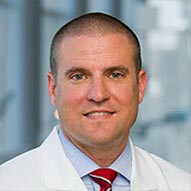Pediatric Nuss procedure
What is the pediatric Nuss procedure?
The Nuss procedure reshapes a sunken chest (pectus excavatum) by placing a metal bar beneath the chest wall to push it outward. Surgeons make small incisions (often as short as three centimeters) on the sides of the chest to insert metal bars. Then they use a camera to guide them as they fix the bar in place. These bars are left in place for 2-3 years. When the chest can hold the new shape on its own, the bars are removed.
What are the benefits of the pediatric Nuss procedure?
A sunken chest wall can interfere with breathing and heart function. If this is the case for your child, we can use the Nuss procedure to create more space for the heart and lungs to work properly.
Having a typical chest shape also enables kids to engage in sports and other activities they couldn’t or wouldn’t try before. Our patients report feeling healthier, more confident and enthusiastic after this procedure. The Nuss procedure is generally safer than other invasive chest wall operations, which involve cutting away cartilage (the soft material that also forms the structure of your nose).
What are the side effects and risks of the pediatric Nuss procedure?
The Nuss procedure doesn’t have many side effects. Some children can have an allergic reaction to the steel bar in their body. We test all our patients before the procedure to see if they’ll have an allergic reaction. We can use a titanium bar if there is an allergy risk. Children can sometimes feel the bar shift slightly when they take a deep breath. About 3% of all patients see their chest sink inward again in the years after the bar is removed.
Pediatric Nuss procedure doctors and providers
 Adam Alder, MDPediatric Surgeon
Adam Alder, MDPediatric Surgeon Lauren Gillory, MDPediatric Surgeon
Lauren Gillory, MDPediatric Surgeon Samir Pandya, MDPediatric Surgeon
Samir Pandya, MDPediatric Surgeon Kim McHard, APRN, PNP-PCNurse Practitioner - Pediatric Surgery
Kim McHard, APRN, PNP-PCNurse Practitioner - Pediatric Surgery